This chapter explains verification and common configuration
procedures for the WebFOCUS Client.
x
Licenses for WebFOCUS components (for example, Magnify)
are managed through the WebFOCUS Administration Console. When additional
WebFOCUS components are purchased, you must add the new license
code using the License Management facility.
x
Procedure: How to Add WebFOCUS Licenses
To
add WebFOCUS licenses:
-
Sign in
to the WebFOCUS Administration Console.
-
In the left
pane, expand Utilities, License
Management, and select WebFOCUS Client.
The License Management dialog opens, as shown in the following image.
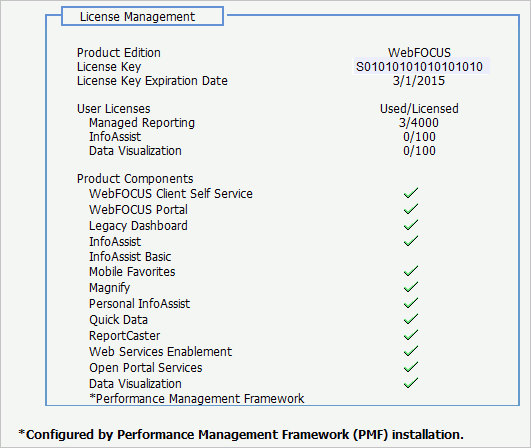
-
Click Enter
New License.
The New License and Site Code field are displayed, as shown
in the following image.
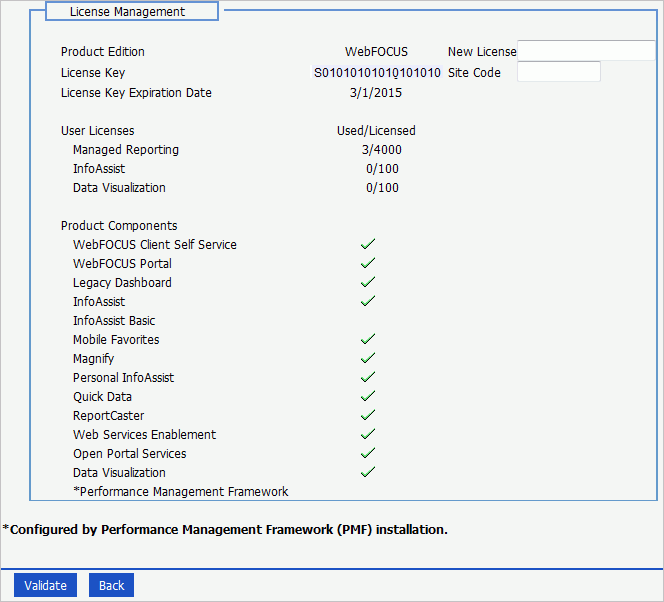
-
Enter your
license and site code, and then click Validate.
-
Restart
the Application Server and ReportCaster Distribution Server for the
changes to take effect.
xConverting WebFOCUS Portals and Favorites When Upgrading
Because the architecture of WebFOCUS Portals and Favorites
has changed in WebFOCUS Release 8.1, Portals and Favorites must
be converted for use in the new architecture. If the Portals and
Favorites were not automatically converted during the upgrade process,
you can run the conversion utilities manually.
x
Procedure: How to Convert WebFOCUS Portals When Upgrading to WebFOCUS Release 8.1
The WebFOCUS Repository must be running to perform the conversion.
Note: If you are upgrading from an earlier version of WebFOCUS Release 8.1, you do not need to convert Portals, only Favorites.
-
Go to
drive:\ibi\WebFOCUS80\utilities\bip.
-
Double-click the portalconversion.bat file.
-
Enter a WebFOCUS administrator ID and password.
-
Select the version of WebFOCUS from which you are migrating:
- Select 1 to select WebFOCUS 77x. This is the default option.
- Select 2 to select WebFOCUS 8x.
- Select q to exit the conversion utility.
-
When the utility has completed the conversion, it will notify you. Press Enter to exit.
The log for the conversion is stored in
drive:\ibi\WebFOCUS80\migration_import\export. The file name is bip_favorites_migration.log.
x
Procedure: How to Convert WebFOCUS Favorites When Upgrading to WebFOCUS 8.1
The WebFOCUS Repository must be running to perform the conversion.
Note: This step must also be performed if you are migrating Favorites from WebFOCUS Release 8.1 Version 00 to WebFOCUS Release 8.1 Version 03 or higher.
-
Go to
drive:\ibi\WebFOCUS80\utilities\bip.
Note: If you have upgraded from WebFOCUS Release 8.1 Version 00 to a later version of Release 8.1, the location will be
drive:\ibi\WebFOCUS81\utilities\bip instead.
-
Double-click the favoritesmigration.bat file.
-
Enter a WebFOCUS administrator ID and password.
-
Select the version of WebFOCUS from which you are migrating:
- Select 1 to select WebFOCUS 77x. This is the default option.
- Select 2 to select WebFOCUS 8x.
- Select q to exit the conversion utility.
-
When the utility has completed the conversion, it will notify you. Press Enter to exit.
The log for the conversion is stored in
drive:\ibi\WebFOCUS80\migration_import\export. The file name is bip_portal_conversion.log.
Note: If you have upgraded from WebFOCUS Release 8.1 Version 00 to a later version of Release 8.1, the location will be
drive:\ibi\WebFOCUS81\migration_import\export instead.
xConfiguring WebFOCUS in a Split Web-Tier and Application Server-Only Environment
In a split web-tier environment, all WebFOCUS web components
run through the application server, and you should not create the
ibi_html and approot aliases on a web server. Instead, you can configure
your application server to serve the content in the
install_directory\ibi\apps directory.

The steps for configuring WebFOCUS to run only in an application
server configuration is similar to split web-tier, in that you configure
the application server to serve static content from the ibi_html
and apps directories. This is described in Using the Static Content Server Option.
The one difference is where the ReportCaster Default Library
URL is pointing. With split web-tier, this setting points to the
web server. In an application server-only configuration, it points
to the application server.
x
Using the Static Content Server Option
WebFOCUS installs a pair of web applications into the
drive:\ibi\WebFOCUS81\webapps
directory, which are designed to serve static content from the file
system to the browser:
- approot.war. Serves
content from the
drive:\ibi\apps
/ibi/apps directory.
- ibi_html.war. Serves
content from the
drive:\ibi\WebFOCUS81\ibi_html
directory.
Deploy one or both of these applications to address the following
split web-tier and stand-alone application server configurations:
Each application includes a deployment descriptor (webconfig.xml)
that is used to locate the directory containing its configuration
file. The context parameter IBI_Configuration_Directory in
webconfig.xml is updated during installation to point to install_directory/ibi/WebFOCUS81/config,
which contains the configuration file approotConfig.xml. The configuration
file is shared by both content server applications even though its
name suggests it would be used by only one. The configuration file
is used to maintain MIME mappings, the physical path of the directories
being served, and the logging level.
The applications also include a Log4J property file (log4j.xml),
which contains the path to the log file used by each application.
The installation updates each log4j.xml file with the path to its
own log file, install_directory/ibi/WebFOCUS81/logs/wfapproot.log
and install_directory/ibi/WebFOCUS81/logs/wfibihtml.log,
respectively.
The content server applications roll the log files over daily
by appending the date to the log file and creating a new one (for
example, wfibihtml.log.2014-01-01). You can increase the log level
by editing install_directory/ibi/WebFOCUS81/config/approotConfig.xml
and changing the log level setting to DEBUG, INFO, WARN, ERROR,
or FATAL, where DEBUG is the most verbose.
There are special considerations for
using the content server option in a clustered web-tier environment.
x
Reference: Using the IBIARCFG and IBIARLOG –D Options With the Content Server Web Applications
Generally
speaking, the approach of specifying a fully qualified path to the
configuration file (approotConfig.xml) in webconfig.xml and of specifying
a fully qualified path to the log files in log4j.xml is sufficient
for most installations. These paths are properly set during installation.
However,
there is an option to pass the content servers these paths from
the Java VM command line. To do this, complete the following steps:
- Edit the WebFOCUS
webconfig.xml file found inside both the approot.war and ibi_html.war
files. Replace the fully qualified path defined in the IBI_Configuration_Directory
parameter with the notation shown below.
<context-param>
<param-name>IBI_Configuration_Directory</param-name>
<param-value>${IBIARCFG}</param-value>
</context-param>
- Edit the WebFOCUS
log4j.xml file located in the approot.war file and replace the fully
qualified path specified by the File parameter, as follows:
<param name="File" value="${IBIARLOG}/wfapproot.log"/>Use a forward slash, even on Windows systems.
- Edit the WebFOCUS
log4j.xml file located inside the ibi_html.war file and replace the
fully qualified path specified by the File parameter, as follows:
<param name="File" value="${IBIARLOG}/wfibihtml.log"/>Use a forward slash even on Windows systems.
- Add the following
–D options in the manner appropriate for the Java VM for your application
server.
The settings below are slightly
different in a clustered web-tier environment.
–DIBIARCFG=install_directory/ibi/WebFOCUS81/config
–DIBIARLOG=install_directory/ibi/WebFOCUS81/logs
xWebFOCUS Client Verification and Configuration
To configure the WebFOCUS Client, edit files either
through a text editor or the WebFOCUS Administration Console. The
WebFOCUS Administration Console also provides tools to verify the
installation.
For NLS configuration information, see the WebFOCUS Security
and Administration manual.
x
Accessing the WebFOCUS Welcome Page
WebFOCUS 8 contains a Welcome page in the WebFOCUS
BI Portal from which you can access WebFOCUS interfaces, such as
the WebFOCUS Administration Console.
x
Procedure: How to Access the WebFOCUS Welcome Page
-
Ensure
that the web or application servers are started and configured.
-
Using
a browser, navigate to the following page:
http://hostname:port/ibi_apps/
where:
- hostname:port
Are the host name and HTTP port of the web server or application
server. For Tomcat stand-alone configurations,
the default is hostname:8080. If you
require SSL, use https instead of http.
The WebFOCUS Sign In page opens,
as shown in the following image.
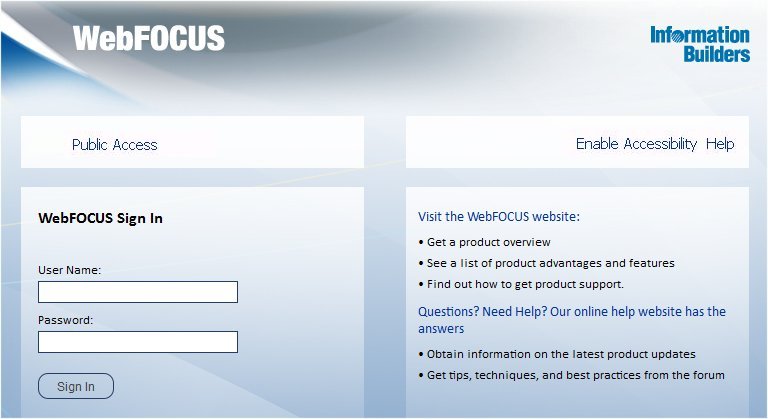
Note: If
you receive a page not found error, ensure that your application
server is started and that you have deployed the WebFOCUS application.
For more information on configuring your application server, see Installing the WebFOCUS Client.
-
Enter the
following default credentials:
- User Name: admin
- Password: admin
Note: If
you receive an invalid user name or password error, ensure
that the WebFOCUS repository has been created and contains initial
table data.
-
Click Sign
In.
The WebFOCUS BI Portal page displays, as shown in the following image.
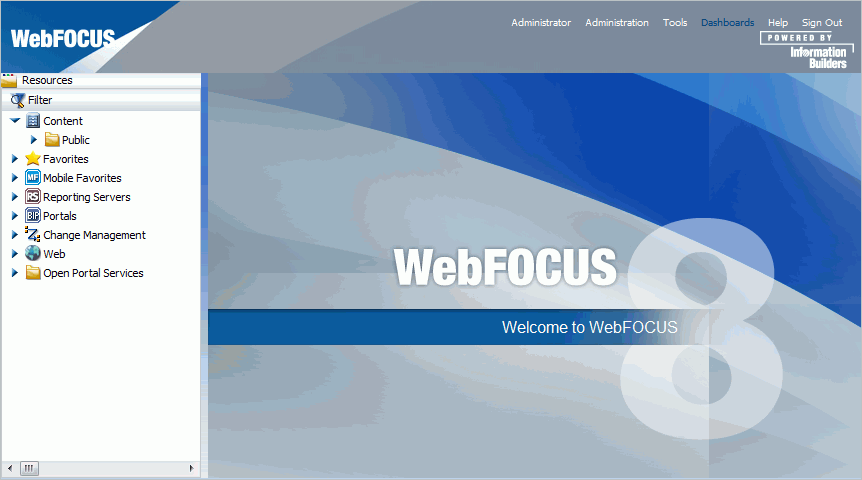
You
can change the default credentials using the Security Center facility.
Click Administration from the top menu, and
then Security Center. For more information,
see the WebFOCUS Security and Administration manual.
x
Accessing the WebFOCUS Administration Console
You can access the WebFOCUS
Administration Console from the WebFOCUS Welcome page, or you can
access the WebFOCUS Administration Console directly from the browser
by supplying its URL.
Access
the WebFOCUS Administration Console using Internet Explorer or Firefox.
x
Procedure: How to Access the WebFOCUS Administration Console
-
Ensure
that the web server and application server are started and configured.
-
Sign
in to the WebFOCUS Welcome page, then click Administration from
the top menu and select Administration Console,
as shown in the following image.
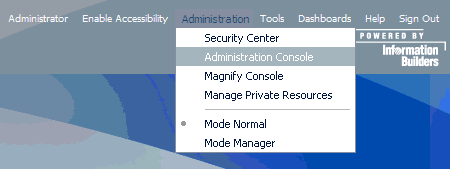
If you are using Windows, you can also
select WebFOCUS Administration Console from
the Programs menu.
You can also manually enter the following
URL in your browser:
http://hostname:port/ibi_apps/console/webfocusconsole.jsp
The
WebFOCUS Sign In page opens, as shown in the following image.

If
a sign-in page does not appear, ensure that your web server and
application server are started and configured.
-
Sign
in using an administrator user ID. By default, admin is a valid
administrator ID, and the password is admin.
Note: After you have verified the WebFOCUS Client
configuration, change the password of the default administrator
user ID, which is admin. For more information on WebFOCUS
Client security, see the WebFOCUS Security and Administration manual.
The WebFOCUS Administration Console opens, as shown in
the following image.
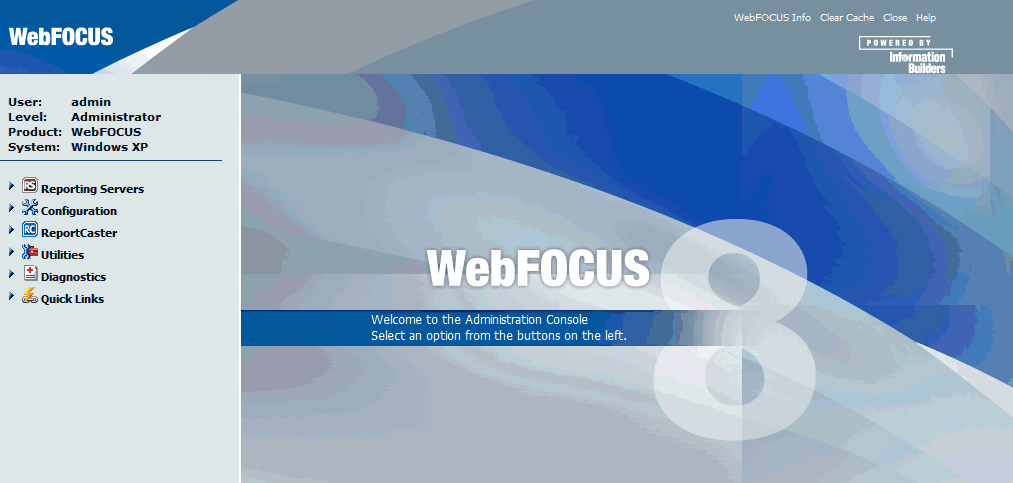
Using
this console, you can edit the WebFOCUS Client communication and security
settings. This console is documented in the WebFOCUS Security
and Administration manual and relevant sections are available
by clicking Help.
x
Running the Verification Tool
The WebFOCUS Administration Console contains a verification
tool to further test the configuration. You
may have already run the verification tool if you chose the option
to configure Tomcat during the WebFOCUS Client installation.
x
Procedure: How to Run the Verification Tool
-
On the
left pane of the WebFOCUS Administration Console, click Diagnostics.
-
Below
Verification, click WebFOCUS Client.
-
Review
the test results and troubleshoot accordingly.
For troubleshooting assistance, see Troubleshooting WebFOCUS and ReportCaster.
x
Setting WebFOCUS Administration Console Authentication
It is a good idea to set authentication for the WebFOCUS
Administration Console. The WebFOCUS Administration Console does
not have its own authentication mechanism and by default, none is
used.
If you wish to set authentication for the console, you can choose
to do this through the WebFOCUS Reporting Server or the web server.
For more information, see the WebFOCUS Security and Administration manual.
x
Defining Communications to WebFOCUS Reporting Servers
WebFOCUS Client communication settings are stored in
the following file:
drive:\ibi\WebFOCUS81\client\wfc\etc\odin.cfg
This file contains node blocks defining WebFOCUS Reporting Servers
that the client accesses. A node block is a set of parameters that
define a server, listener, or other communication component.
When you installed the WebFOCUS Client, you specified a default
WebFOCUS Reporting Server that the client accesses. If this is the
only server the client will access, you can proceed to Configuring Static Authentication.
To change connection information for the default server or define
additional servers, use the procedures that follow.
x
Procedure: How to Define WebFOCUS Reporting Servers
-
On the
left pane of the WebFOCUS Administration Console, click Reporting
Servers.
-
Under
Reporting Servers, click Remote Services.
The right pane displays all defined WebFOCUS Reporting
Servers. To edit parameters of a defined WebFOCUS Reporting Server,
select its radio button and click Modify.
-
To define
an additional node, click New.
-
Enter
a unique name for the new NODE. Use this name when you wish to access
the server.
This page lets you choose to define a single server (Client), CLM
Processing, or a Cluster node.
A cluster node is a node that consists of multiple servers. When
the client accesses the cluster, it chooses one of the servers in
that cluster. This is used for load balancing and fail over. The best way to use clusters is
through the Cluster Manager component that you can optionally add
to your WebFOCUS environment.
-
Click Next.
-
Complete
the HOST and PORT fields.
The remaining fields are optional in most environments.
Note: Setting
the User ID and Password here is not recommended and may not have
the desired result.
-
Click Save.
-
On the
top of the page, click Clear Cache so your
changes take effect.
x
Procedure: How to Set the Default WebFOCUS Reporting Server
When
you make a connection from client to server without specifying a
server, the default server is used. The default server and many
other settings are set in the following file:
drive:\ibi\WebFOCUS81\client\wfc\etc\cgivars.wfs
The
following variable specifies the default server:
IBI_REPORT_SERVER
To
set this using the WebFOCUS Administration Console:
-
On the
left pane of the WebFOCUS Administration Console, under Configuration,
click Client Settings and then click Reporting
Server.
-
In the IBI_REPORT_SERVER field,
type the node name of the default server.
-
Click Save on
the bottom of the page.
-
On the
top of the page, click Clear Cache.
x
Configuring Static Authentication
When the client accesses a WebFOCUS Reporting Server
running with security, the client must sign in to the server for
tasks, such as browsing metadata, listing files, or running reports.
Either your applications or users can provide credentials, or you
can use Static Authentication. With Static Authentication, you specify
a user ID and password that the client always passes to the server.
This can be set for all servers or for each individual server. Static
authentication ensures that every WebFOCUS Client connection to a
server accesses the server using the same environment configuration.
Note: In some environments, you may be able to use Trusted
Authentication (Already Verified Processing) instead of Static Authentication.
For more information, see the WebFOCUS Security and Administration manual.
This section only addresses static authentication.
The following variables define static authentication:
IBI_REPORT_USER
IBI_REPORT_PASS
You should set these variables using the WebFOCUS Administration
Console so you can encrypt the file containing your password. Static
authentication is defined globally for all nodes in the cgivars.wfs
file. Static authentication can be defined for a specific node by creating
a profile with the node name.
x
Procedure: How to Set Static Authentication Globally
These steps set sign-in credentials
that are used when accessing all servers.
-
On the
left pane of the WebFOCUS Administration Console, click Configuration.
-
Under Client
Settings, click Reporting Server.
-
Provide
the credentials to use for static authentication in the IBI_REPORT_USER and IBI_REPORT_PASS fields.
-
Select
the ENCRYPT checkbox to ensure that the file
cannot be read through the file system. This is recommended because
the file contains a user ID and password.
-
Click Save.
-
On the
top of the page, click Clear Cache so your
changes take effect.
x
Procedure: How to Set Static Authentication for a Specific Node
These
steps set sign-in credentials that are used when accessing a specific
node (a server or a cluster).
-
On the
left pane of the WebFOCUS Administration Console, click Reporting
Servers.
-
Under
Reporting Servers, click Remote Services.
The right pane displays defined WebFOCUS Reporting Servers.
-
Select
the node for which you are setting authentication, and click Profile.
-
Uncomment one pair of IBI_REPORT_USER and IBI_REPORT_PASS lines,
and set them to the account you wish to use.
-
Select
the ENCRYPT checkbox to ensure that the credentials
cannot be read through the file system.
-
Click Save.
A profile for the node is created if it does not already exist.
For
additional information on using the WebFOCUS Administration Console, click Help or
see the WebFOCUS Security and Administration manual.
x
Enabling Active Technologies
Although most WebFOCUS Client features are configured
through the WebFOCUS Administration Console, some features are enabled
and configured through the WebFOCUS Reporting Server. If you license
Active Technologies, you must provide the Active Technologies license
code in the WebFOCUS Reporting Server Web Console.
x
Procedure: How to Enable Active Technologies
-
Sign in to the WebFOCUS Reporting Server
Web Console.
This console was introduced in How to View the Web Console and Test the Server.
-
Click
the Workspace tab.
-
Right-click
the Workspace folder in the navigation pane
and select License, or click License on
the ribbon.
-
Enter
your Active Technologies license in the license_active_report field,
and click Save and Restart Server.
x
Active Technologies for Adobe Flash Consideration
Active Technologies for Adobe® Flash® is generated using
a Java-based compiler engine that is included with Adobe Open Source
Flex SDK for the WebFOCUS Reporting Server. There is a known issue
with the Adobe Flex® compiler not working properly with the IBM
version of Java due to a conflict between the version of Xerces
that the Flex software uses and the one that is included with the
IBM JVM. As a workaround, ensure that the JVM loads the version
of Xerces supplied with the Flex software instead of the version supplied
with the IBM JVM.
Make sure the Flex compiler uses the xercesImpl.jar file
that is provided in the Flex library folder under the ibi folder.
Add the following syntax into the user ID profile that starts the
WebFOCUS Reporting Server:
export CLASSPATH=/ibi/srv81/home/etc/flex/lib/xercesImpl.jar:$CLASSPATH
This must be set in the CLASSPATH because the Flex compiler does
not read the IBI_CLASSPATH when it is executed.
xSetting Tomcat HTTP POST Maximum Size
As a default, Apache Tomcat sets the maximum size limit
to 2097152 (2MB) limit for accepting HTTP POST requests. Since EXL07
MIME files can easily reach this limit, ExcelServlet will fail
with a HTTP 400 error or produce a corrupted .XLSX file. To fix
this problem, Tomcat needs to be configured by setting an attribute
in the server.xml file.
In the /tomcat_home/conf/server.xml file, add the maxPostSize attribute
and set it to 0 to disable the limit check. The following example demonstrates
this with the <Connector port> element block:
<Connector port="8080" protocol="HTTP/1.1"
connectionTimeout="20000"
redirectPort="8443" maxPostSize="0" />
xWebLogic Post-Installation Step
When
configuring WebLogic®,
you must perform the following post-installation step.
You must
create a new file called weblogic.xml in the WEB-INF directory for
the WebFOCUS web application. It must contain the following information:
<?xml version="1.0" encoding="UTF-8"?>
<wls:weblogic-web-app
xmlns:wls="http://xmlns.oracle.com/weblogic/weblogic-web-app"
xmlns:xsi="http://www.w3.org/2001/XMLSchema-instance"
xsi:schemaLocation="http://java.sun.com/xml/ns/javaee
http://java.sun.com/xml/ns/javaee/ejb-jar_3_0.xsd
http://xmlns.oracle.com/weblogic/weblogic-web-app
http://xmlns.oracle.com/weblogic/weblogic-web-app/1.4/weblogic-web-app.xsd">
<wls:container-descriptor>
<wls:prefer-application-packages>
<wls:package-name>org.eclipse.persistence</wls:package-name>
</wls:prefer-application-packages>
</wls:container-descriptor>
</wls:weblogic-web-app>
Once the file is saved,
you must recreate the .war file by adding it to webfocus.war. The
.war file can be renamed based on your naming convention, and then redeployed.






